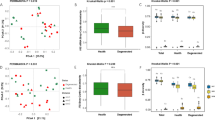Summary
Abundance and distribution of vascular plants and vesicular-arbuscular mycorrhizal (VAM) fungi across a soil moisture-nutrient gradient were studied at a single site. Vegetation on the site varied from a dry mesic paririe dominated by little bluestem (Schizachyrium scoparium) to emergent aquatic vegetation dominated by cattail (Typha latifolia) and water smartweed (Polygonum hydropiperoides). Plant cover, VAM spore abundance, plant species richness, and number of VAM fungi represented as spores, had significant positive correlations with each other and with percent organic matter. The plant and VAM spore variables had significant negative correlations with soil pH and available Ca, Mg, P and gravimetric soil moisture. Using stepwise multiple regression, Ca was found to be the best predictor of spore abundance. Test for association between plant species and VAM fungal spores indicated that the spores of Glomus caledonium are associated with plants from dry, nutrient poor sites and spores of gigaspora gigantea are positively associated with plants occurring on the wet, relatively nutrient rich sites. Glomus fasciculatum was the most abundant and widely distributed VAM fungus and it had more positive associations with endophyte hosts than the other VAM fungi. We found no relationship between beta niche breadth of plant species and the presence or absence of mycorrhizal infection. However, our data suggest that some plant species may vary with respect to their infection status depending upon soil moisture conditions that may fluctuate seasonally or annually to favor or hinder VAM associations.
Similar content being viewed by others
References
Allen MF, Moore TS, Christensen M, Stanton N (1979) Growth of vesicular-arbuscular mycorrhizal and non-mycorrhizal Bouteloua gracilis in a defined medium. Mycologia 71:666–669
Allen MF, Sexton JC, Moore TS, Christensen M (1981) Influence of phosphate source on vesicular-arbuscular mycorrhizae of Bouteloua gracilis. New Phytol 87:687–694
Anderson RC, Liberta AE, Dickman LA, Katz AJ (1983) Spatial variation in vesicular-arbuscular mycorrhiza spore density. Bull Torrey Bot Club 110:519–525
Azcon R, Gomez-Ortega M, Barea JM (1982) Comparative effects of foliar-or soil-applied nitrate on vesicular-arbuscular mycorrhizal infection in maize. New Phytol 92:553–559
Barnes P, Harrison T (1982) Species distribution and community organization in a Nebraska sandhills mixed prairie as influenced by plant/soil-water relationships. Oecologia (Berl) 52:192–201
Biermann B, Linderman R (1981) Quantifying vesicular-arbuscular mycorrhizae: a proposed method towards standardization. New Phytol 87:63–67
Clarke R (1977) Habitat distribution and species diversity of Chaetodontid and pomacentrid fishes near Bimini, Bahamas. Marine Biology 40:277–289
Cole L (1949) The measure of interspecific association. Ecology 30:411–424
Colwell R, Futuyma D (1971) On the measurement of niche breadth and overlap. Ecology 52:567–576
Gerdemann J, Trappe J (1974) The Endogonaceae in the Pacific Northwest. Mycol Mem 5:1–76
Hetrick BD, Bloom J (1983) Vesicular-arbuscular mycorrhizal fungi associated with native tall grass prairie and cultivated winter wheat. Can J Bot 61:2140–2146
Hirrel M, Mehravaran H, Gerdemann J (1978) Vesicular-arbuscular mycorrhizae in the Chenopodiaceae and cruciferae: do they occur? Can J Bot 56:2813–2817
Hurlbert H (1969) A coefficient of interspecific association. Ecology 50:1–9
Iqbal SH, Tauqir S (1982) The influence of soil moisture contents on VA endophytes of mycorrhizal cereals and subsequent production of endogenous spores by them. Bull Mycol 2:59–68
Koske R, Halvorson W (1981) Ecological studies of vesicular-arbuscular mycorrhizae in a barrier sand dune. Can J Bot 59:1413–1422
Liberta AE, Anderson RC, Dickman LA (1983) Vesicular-arbuscular mycorrhiza fragments as a means of endophyte identification at hydrophytic sites. Mycologia 75:169–171
Miller R (1979) Some occurrences of vesicular-arbuscular mycorrhiza in natural and disturbed ecosystems of the Red Desert. Can J Bot 57:619–623
Nelson D, Anderson R (1983) Factors related to the distribution of prairie plants along a moisture gradient. Am Midl Nat 109:367–375
Newman E, Heap A, Lawley R (1981) Abundance of mycorrhizas and root surface micro-organisms of Plantago lanceolata in relation to soil and vegetation: a multi-variate approach. New Phytol 89:95–108
Parrish J, Bazzaz F (1979) Difference in pollination niche relationships in early and late successional plant communities. Ecology 60:597–610
Parrish J, Bazzaz F (1982a) Response of plants from three successional communities to a nutrient gradient. J Ecol 70:233–248
Parrish J, Bazzaz F (1982b) Competitive interactions in plant communities of different successional ages. Ecology 63:314–320
Peet R, Loucks O (1977) A gradient analysis of southern Wisconsin forests. Ecology 58:485–499
Phillips J, Hayman D (1970) Improved procedures for clearing roots, staining parasitic and vesicular-arbuscular mycorrhizal fungi for rapid assessment of infection. Trans Br Mycol Soc 55:158–161
Piekett S, Bazzaz F (1976) Divergence of two co-occurring annuals on a soil moisture gradient. Ecology 57:169–175
Pickett S, Bazzaz F (1978a) Organization of an assemblage of early successional species on a soil moisture gradient. Ecology 59:1248–1255
Pickett S, Bazzaz F (1978b) Germination of co-occurring annual species on a soil moisture gradient. Bull Torrey Bot Club 105:312–316
Rabatin S (1979) Seasonal and edaphic variation in vesicular-arbuscular mycorrhizal infection of grasses by Glomus tenuis. New Phytol 83:95–102
Trappe J (1982) Synoptic keys to the genera and species of zygomycetous mycorrhizal fungi. Phytopathology 72:1102–1108
Whittaker R, Levins S, Root R (1973) Niche, habitat and ecotope. Am Naturalist 107:321–338
Author information
Authors and Affiliations
Rights and permissions
About this article
Cite this article
Anderson, R.C., Liberta, A.E. & Dickman, L.A. Interaction of vascular plants and vesicular-arbuscular mycorrhizal fungi across a soil moisture-nutrient gradient. Oecologia 64, 111–117 (1984). https://doi.org/10.1007/BF00377552
Received:
Issue Date:
DOI: https://doi.org/10.1007/BF00377552




